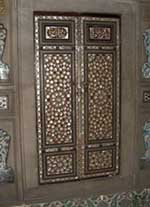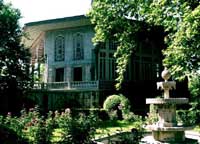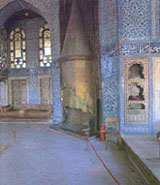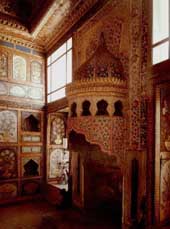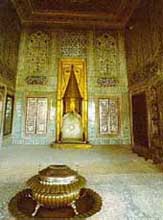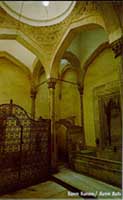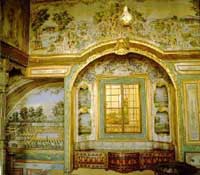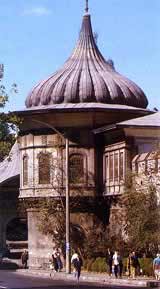Marble Terrace in 4th Court (click pic. to enlarge)

Iftariye Kameriyesi (1640)
Interior closets excellent examples of Turkish workmanship (click picture to enlarge)
The access to fourth court is beside the building containing the miniature collections. In this court there are a number of pavilions built by various Sultans. The "Bagdat" and the "Revan" Pavilions built by Murat IV are outstanding both in terms of architecture and interior design. Between the Bagdat and the Revan Pavilions is a marble terrace with a pool in the centre. The view from the terrace is looking over the Golden Horn and the Bosphorus.
Built in 1635 by the architect Koca Kasim, Revan Pavilion is a small replica of the Baghdad Pavilion. The windows are decorated with a double line of mother -of -pearl and tortoise shell. The central brazier was a gift of the French King Louis XV, to Mahmut I. This room was also known as the Turban Room, as it was here that the sultanís turbans were kept.
On the way to Baghdad Pavilion, the heavily tiled outer wall of the Circumcision Room (16th century), and the lovely gilt - bronze baldachin (like an open kiosk) of Sultan Ibrahim called "Iftariye Kameriyesi" dating from 1640 where the Sultan used to broke his daily fasts during the Month of Fasting (Ramazan) at the sunset can be seen.
Bagdat Pavilion was built in 639 by the architect Koca Kasim. This pavilion is also eight sided, and surrounded by marble columns supporting a broad overhanging roof line, in a circular portico. Like the Revan Pavilion, the lower walls are marble and the upper walls are tiled. The mother - of pearl and tortoise shell inlay work are seen in the doors and window frames. The interior closets are excellent examples of Turkish workmanship. The wall spaces throughout are totally covered in tile. From the heavily decorated dome hangs a golf - leafed sphere. Seating divans are covered in velvet fabrics.
The Sofa Pavilion is either known as "Merdiven Kasri" or the Pavilion of Mustafa Pasha. It is in the centre of the fourth court and was built in the tulip gardens during the reign of Ahmed III. It is the only wooden pavilion of its kind.
Other buildings in this court are "The Mecidiye Pavilion", "Esvap Odasi" (Privy Wardrobe), and the Sofa Mosque. Mecidiye Pavilion of Sultan Abdulmecid is now used as a restaurant.
Interior view of Revan Pavilion (click pic. to enlarge)
Bagdat Pavilion (click to enlarge)
Bagdat Pavilion Interior

